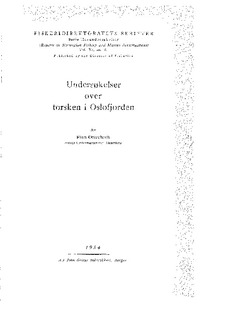| dc.contributor.author | Otterbech, Finn | |
| dc.date.accessioned | 2008-11-19T10:03:10Z | |
| dc.date.issued | 1954 | |
| dc.identifier.uri | http://hdl.handle.net/11250/114566 | |
| dc.description.abstract | "The Cod Population of the Oslofjord".
The hydrographical conditions of the fjord are mentioned. Owing
to the sills at Drøbak and Nesodden the water masses of the inner
fjord are often insufficiently aerated (Fig. 1 shows a plan of the fjord).
In addition to my own material for the years 1939-51, consisting
of spring - and autumn - samples, results from investigations carried
out by Ruud 1936-38 and by several investigators at the Flødevig
Sea Fish Hatchery are taken into consideration.
The distribution of the egg stages is quite different in the inner
and outer fjord. In the inner fjord - north of Drøbak - few eggs
in advanced stages are found. The number of young fish of the
0-group is also very low in this part of the fjord. (Fig. 3). As possible
explanations to this phenomenon the effect of bacteria has been
discussed (Fig. 2).
The strength of the year-classes varies. Very abundant are the
1938- and 1945-, especially poor the 1940-, 1941-, 1946- and
1947-yearclasses (Fig. 4). These differences are brought foreward
already when the fish are at an age of half a year (see fig. 3). The
cod in the inner Oslofjord is characterized by a low number of
vertebrae, otoliths with many secondary zones and very stationary
habits.
Annual mortality averages 80 %, a value considerably higher
than for cod from other localities in Southern Norway. More than
60 % of the fish are 1½ and 2 years old, mainly due to the low
size limit - 30 cm from 1947.
Males attain maturity earlier than the females (fig. 5). At an
age of 2 years about 30% of the fish have ripe sex products.
My values for the length of 1-4 year old cod 1939-51 are 2-4
cm lower than the corresponding values for the years 1936-38 (Fig.
6). This is a consequence of the extremely slow growth of the rich
1945-yearclass.
The yield of the fishery has decreased alarmingly during the last
25 years (Fig. 7). The peaks of the curve are due to the influence of
the 1945-, 1948- and 1949-year-classes.
To obtain a higher yield the following possibilities have been
discussed:
I. Raise of the size limit to 35 cm.
2. Control with dumping of sewage etc. in the fjord.
3. Release of fry. | |
| dc.format.extent | 699901 bytes | |
| dc.format.mimetype | application/pdf | |
| dc.language.iso | nob | en |
| dc.publisher | [Fiskeridirektoratets havforskningsinstitutt] | en |
| dc.relation.ispartofseries | Fiskeridirektoratets skrifter, Serie Havundersøkelser | en |
| dc.relation.ispartofseries | vol 11 no 2 | en |
| dc.title | Undersøkelser over torsken i Oslofjorden | en |
| dc.type | Research report | en |
| dc.source.pagenumber | 17 s. | en |
